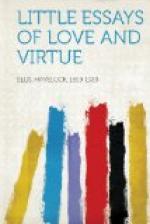On the whole, the fundamental traditions of our western world concerning the duties of husbands and wives are well summed up in what Pollock and Maitland term “that curious cabinet of antiquities, the marriage ritual of the English Church.” Here we find that the husband promises to love and cherish the wife, but she promises not only to love and cherish but also to obey him, though, it may be noted, this point was not introduced into English marriage rites until the fourteenth century, when the wife promised to be “buxom” (which then meant submissive) and “bonair” (courteous and kind), while in some French and Spanish rites it has never been introduced at all. But we may take it to be generally implied. In the final address to the married couple the priest admonishes the bride that the husband is the head of the wife, and that her part is submission. In some more ancient and local rituals this point was further driven home, and on the delivery of the ring the bride knelt and kissed the bridegroom’s right foot. In course of time this was modified, at all events in France, and she simply dropped the ring, so that her motion of stooping was regarded as for the purpose of picking it up. I note that change for it is significant of the ways in which we modify the traditions of the past, not quite abandoning them but pretending that they have other than the fundamental original motives. We see just the same thing in the use of the ring, which was in the first place a part of the bride-price, frequently accompanied by money, proof that the wife had been duly purchased. It was thus made easy to regard the ring as really a golden fetter. That idea soon became offensive, and the new idea was originated that the ring was a pledge of affection; thus, quite early in some countries, the husband, also wore a wedding ring.
The marriage order illustrated by the Paston Letters and the Book of the Chevalier de la Tour-Landry before the Reformation, and the Anglican Book of Common Prayer afterwards, has never been definitely broken; it is a part of our living tradition to-day. But during recent centuries it has been overlaid by the growth of new fashions and sentiments which have softened its hard outlines to the view. It has been disguised, notably during the eighteenth century, by the development of a new feeling of social equality, chiefly initiated in France, which, in an atmosphere of public intercourse largely regulated by women, made the ostentatious assertion of the husband’s headship over his wife displeasing and even ridiculous. Then, especially in the nineteenth century, there began another movement, chiefly initiated in England and carried further in America, which affected the foundations of the husband’s position from beneath. This movement consisted in a great number of legislative measures and judicial pronouncements and administrative orders—each small in itself and never co-ordinated—which taken altogether have had a cumulative effect in immensely increasing the rights of the wife independently of her husband or even in opposition to him. Thus at the present time the husband’s authority has been overlaid by new social conventions from above and undermined by new legal regulations from below.




